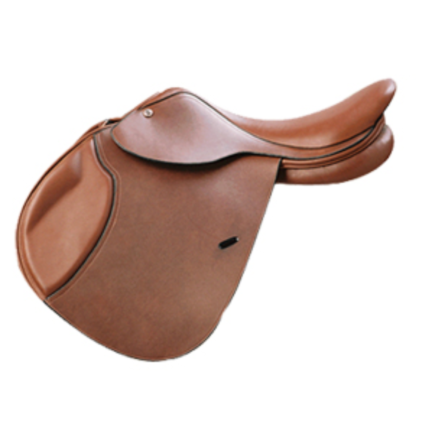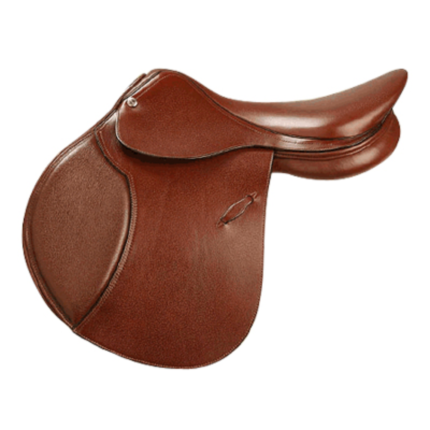A jumping saddle, also known as an all-purpose or close contact saddle, is a type of English saddle designed specifically for the discipline of show jumping. It provides the rider with a secure and balanced seat while allowing freedom of movement to perform over jumps. Here’s an in-depth look at a jumping saddle:
Functionality
- Security and Stability: Jumping saddles are designed to provide riders with a secure seat, allowing them to stay balanced and centered over jumps.
- Close Contact: The design facilitates close contact between the rider and the horse, enabling subtle communication and precise aids during jumping efforts.
- Freedom of Movement: The saddle’s design allows the rider’s leg to remain close to the horse’s side, facilitating effective use of leg aids while still providing support.
Design and Features
- Forward Flaps: The flaps are positioned more forward than in dressage saddles, allowing the rider to maintain a balanced position over jumps.
- Shorter Flaps: The flaps are typically shorter than those of dressage saddles to accommodate the shortened stirrup length often used in jumping.
- Padded Knee Rolls and Thigh Blocks: These provide additional support for the rider’s leg, helping to maintain a secure position during jumps.
- Shallow Seat: Unlike the deep seat of dressage saddles, jumping saddles have a shallower seat to allow the rider to easily adjust their position while jumping.
- High Pommel and Cantle: The higher pommel and cantle offer additional security and support for the rider’s position over jumps.
- Close Contact Panels: The panels are designed to distribute the rider’s weight evenly over the horse’s back while maintaining close contact.
- Forward Stirrup Bars: These are positioned slightly forward to accommodate the rider’s shortened stirrup length for jumping.
Materials
- Leather: High-quality leather is commonly used for jumping saddles due to its durability, comfort, and ability to conform to the rider’s and horse’s shapes over time.
- Synthetic Materials: Some modern jumping saddles are made from synthetic materials that are lighter, more affordable, and easier to maintain while still providing support and durability.
Types of Jumping Saddles
- Close Contact: These saddles are designed specifically for show jumping and provide a close contact feel between the rider and horse.
- All-Purpose: These saddles are versatile and can be used for both jumping and flatwork. They feature a slightly deeper seat than close contact saddles.
- Monoflap: These saddles have a single layer of leather between the horse and rider, providing even closer contact and enhanced communication.
- Cross Country: Designed for eventing, these saddles feature a slightly more forward flap and extra security features to accommodate the demands of cross-country jumping.
Usage and Considerations
- Fit: Ensuring proper fit for both horse and rider is crucial. A well-fitted saddle enhances comfort, performance, and safety.
- Maintenance: Regular cleaning and conditioning of the leather are essential to keep the saddle in good condition and prolong its lifespan.
- Customization: Many jumping riders opt for custom saddles tailored to their specific measurements and preferences, ensuring optimal fit and comfort.
Benefits
- Enhanced Performance: Jumping saddles are designed to support the rider’s position and provide stability, allowing for better performance over jumps.
- Close Contact: The design promotes close communication between rider and horse, facilitating precise aids and better control.
- Versatility: While primarily used for show jumping, jumping saddles can also be suitable for other disciplines like cross-country and general riding.








Reviews
There are no reviews yet.